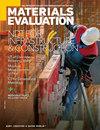Automated Robotic Systems for Nondestructive Testing of Aerospace Composite Structures
IF 0.3
4区 材料科学
Q4 MATERIALS SCIENCE, CHARACTERIZATION & TESTING
引用次数: 0
Abstract
Automated robotic systems are becoming prevalent in many aerospace manufacturing applications, such as laser ablation, sanding, drilling, final assembly, and painting. There are significant advantages to using automated robotic systems for inspection purposes as well: versatility, speed, and repeatability, to name a few. This paper explores using an automated robotic system for the nondestructive testing (NDT) of composite parts. It has a focus on phased array ultrasonic testing (PAUT) but highlights modularity principles in the system that are not coupled to a single inspection method. Because of the articulation inherent in multi-axis robots, inspections of contoured structures become straightforward if the system modules are designed correctly. Examples of such modules, and their advantages when interfaced to an automated robotic system, are included in this paper. It is the author’s intent to show how these system modules might maximize robot capabilities for a broad range of aerospace inspections while keeping a simplistic design that is modular, fast, and straightforward to use. When compared to other aerospace manufacturing processes already using automated robotic systems, the use of robots for NDT seems not only prudent but a favorable goal. This paper offers practical building blocks for achieving this goal.航空复合材料结构无损检测的自动化机器人系统
自动化机器人系统在许多航空航天制造应用中变得越来越普遍,例如激光烧蚀、打磨、钻孔、最终装配和涂装。使用自动化机器人系统进行检查也有显著的优点:多功能性、速度和可重复性,仅举几例。本文探讨了利用自动化机器人系统对复合材料零件进行无损检测。它侧重于相控阵超声检测(PAUT),但强调系统中的模块化原则,而不是与单一检测方法相耦合。由于多轴机器人固有的关节,如果系统模块设计正确,轮廓结构的检查变得简单。这些模块的例子,以及它们在与自动化机器人系统接口时的优势,都包括在本文中。这是作者的意图,以显示如何这些系统模块可能最大限度地提高机器人的能力,为广泛的航空航天检查,同时保持一个简单的设计,是模块化的,快速的,直接使用。与其他已经使用自动化机器人系统的航空航天制造过程相比,使用机器人进行无损检测似乎不仅是谨慎的,而且是一个有利的目标。本文为实现这一目标提供了实用的构建模块。
本文章由计算机程序翻译,如有差异,请以英文原文为准。
求助全文
约1分钟内获得全文
求助全文
来源期刊

Materials Evaluation
工程技术-材料科学:表征与测试
CiteScore
0.90
自引率
16.70%
发文量
35
审稿时长
6-12 weeks
期刊介绍:
Materials Evaluation publishes articles, news and features intended to increase the NDT practitioner’s knowledge of the science and technology involved in the field, bringing informative articles to the NDT public while highlighting the ongoing efforts of ASNT to fulfill its mission. M.E. is a peer-reviewed journal, relying on technicians and researchers to help grow and educate its members by providing relevant, cutting-edge and exclusive content containing technical details and discussions. The only periodical of its kind, M.E. is circulated to members and nonmember paid subscribers. The magazine is truly international in scope, with readers in over 90 nations. The journal’s history and archive reaches back to the earliest formative days of the Society.
 求助内容:
求助内容: 应助结果提醒方式:
应助结果提醒方式:


